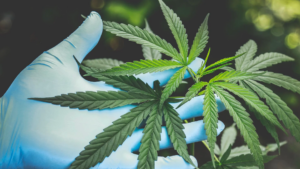Is it possible to use cannabis to create an alternative beverage to alcohol? Wunder is a California-based company seeking to solve that question. Coming from a health-conscious perspective, it aims to innovate a cannabis beverage that can serve as an alternative to drinking alcohol.
Following that mindset, Wunder aims to disrupt the beverage industry by creating an accessible product aimed towards new users. Its brand philosophy is to bring new customers to cannabis by innovating in a familiar form factor.
Ryan Eidson, Wunder’s director of sales, spoke to students at USC about his work and vision for the company’s future.
Not Necessarily a “Stoner” Drink
Wunder’s objective was to engineer a beverage tailored to the health-conscious tastes of the modern day consumer.
“Alcohol has always been there for any type of celebration or event, and always has this stranglehold on fun activities … Wunder’s looking at the opportunity as a true alcohol replacement and healthier alternative to potentially a destructive lifestyle,” Eidson explained.
Wunder is currently sold in over 110 stores in California, and Eidson said they plan to expand interstate by next year.
The concept of a ready-to-drink cannabis beverage is rather novel. Eidson said it is about four years old. While that novelty could be a challenge, it gives Wunder the opportunity to reach a target market much larger than just the cannabis industry alone.
The Demand for Something New
A study from the BDSA, a leading cannabis research firm, found that 60% of adults in fully legal states either already consume or are open to consuming cannabis in the future.
Based on this figure, Eidson drew out his vision for expanding Wunder’s market. The United States’ legal cannabis market is worth $20 billion. Meanwhile, retail demand for alcohol was over $250 billion in 2019, which has grown since the pandemic.
Based on this disparity of the markets, Wunder plans to use the existing demand for alcohol to introduce consumers to the cannabis market.
“You may have been introduced to cannabis through flower, through a joint, through vape or bong, whatever that may be, but you think about alcohol, you think about beverages, that is something we consume and we’re often used to consuming every day.”
Wunder’s form factor is meant to ease new users into cannabis by simplifying the consumption process.
“We wanted to create a drink that ultimately mimics the positive effects of drinking alcohol,” Eidson said. The standard Wunder beverage contains 10 milligrams of THC and is designed to mimic the effects of a low-volume alcoholic drink such as beer or seltzer.
Unlike the alcoholic alternatives, Wunder takes a more health conscious approach. A can of Wunder only contains 25-35 calories, as well as under four grams of sugar.
A Unique Buzz
To achieve the desired effect, Wunder designed its products for a specific type of high. Wunder is sessionable, with a rapid 10-minute onset, and the effect typically lasts for 30 to 45 minutes.
Eidson explained that because the cannabis is infused in a beverage form, they can design a means of getting cannabinoids in the bloodstream faster than a traditional infused edible.
The mechanism behind this is called microemulsion, which refers to the size of cannabis droplets inside the beverage. By having the cannabinoids spread out, it means that it takes less time for the body to process them, and achieves the desired effect quicker.
Eidson continued, saying that they designed Wunder’s taste to be like a carbonated fruit beverage. With flavors such as blood orange bitters, and lemon ginger, “It’s robust, it’s refreshing, it’s bold,” Eidson said.
A Taste of Delta-8
One aspect that sets Wunder apart is the way it experiments with cannabinoids. Eidson explained why their focus turned to compounds beyond traditional THC.
“We found that putting too much THC-9 into a drink provided this really fuzzy head high that left you in the clouds and sometimes not functional. People are sensitive to THC and so having that head high can be uncomfortable and cause a little bit of anxiety,” Eidson said.
Wunder’s researchers set out to isolate and research compounds outside of THC-9 to see how it could improve its formula.
Thanks to this experimentation, Wunder was the first beverage brand featuring delta-8 THC, which has been in recent news for its ability to be extracted from hemp plants, which are federally legalized in the United States.
Delta-8 has come under controversy over its safety, due to the fact that hemp is chemically treated to synthesize the compound, and regulations are not yet implemented. as the FDA put out warnings surrounding hemp-derived delta-8 products, and it is banned or restricted in 19 states.
However, in California, delta-8 products undergo rigorous testing and extraction methods to ensure consumer safety, unlike hemp delta-8 in other markets.
For Wunder, delta-8 might be the solution to advance the cannabis beverage experience. Eidson explained that it provided a mellower, more relaxing effect compared to THC-9. “I like to call it THC light.” He said.
By incorporating delta-8 THC alongside THC-9 and CBD, Wunder created a balanced approach meant to invite new cannabis users, or those who were simply looking to unwind.
“Something you could take to a party and consume and not be too foggy or too hazy or too stoned,” Eidson noted.
Wunder’s research won’t stop at delta-8. Eidson believes that the beverage format is a platform for innovation. He said, “everything from different feelings and effects to flavors, profile … we’re working on a line right now that’s going to incorporate caffeine.”
What’s next for WUNDER?
Being in such a rapidly moving and young industry, Eidson expressed the high-pressure nature of making decisions in Wunder’s business landscape.
He believes that the cannabis industry is moving twice as fast as when he worked in the tech industry in the early 2000’s. However, he believes that challenge brings the opportunity of expanding the market to new users.




